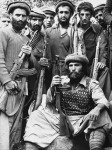
Afghanistan is a small landlocked country in central Asia. During the Cold War, it shared borders with Soviet republics to the north, Iran to the west and Pakistan in the south. With its remote location, mountainous terrain and harsh climate, Afghanistan has been viewed in the West as a place of mystery and some instability. As a crossroads nation bridging East and West, Afghanistan has always had strategic importance. For much of the Cold War, Afghanistan was ruled by Mohammed Zahir, an educated and somewhat enlightened Shah (king) who made sincere attempts to modernise his country. By the mid-1960s, Afghanistan had most of the features of a modern democratic state: free elections, a representative parliament and reforms improving the rights of women. Zahir and his government refused to align with either the United States or Soviet Union, even though Washington and Moscow both courted him by funding roads and other infrastructure projects.
In 1973, while Mohammed Zahir was abroad having surgery, he was deposed by a bloodless coup. This coup was led by Mohammed Daoud Khan, Zahir’s cousin and the prime minister. Daoud immediately abolished the monarchy and took the office of president. He summoned a loya jirga (‘grand council of tribes’) to approve a new constitution that transformed Afghanistan into a one-party republican state. Daoud sought to undermine communist opposition to his government by reducing Afghanistan’s reliance on the USSR. Instead, he sought to forge ties with oil-rich Muslim nations like Egypt, Iran and Saudi Arabia. Fearful that Daoud would eventually align with the West, Soviet agents and local communists began to plot his downfall. In 1978 Daoud was removed in a coup – the so-called Saur Revolution – organised by Afghanistan’s Communist People’s Democratic Party (PDPA) and conducted by sympathetic army officers. The PDPA proclaimed victory on April 28th by announcing that Daoud had “resigned due to poor health” (this was partly true: he had been shot).
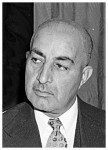
By 1979, the instability in Afghanistan had increased markedly and the government was on the brink of collapse. Confronted with anarchy and imminent revolution, the communist regime in Kabul made frequent pleas to Moscow for military intervention. In December 1979 the Kremlin acted, sending more than 100,000 Red Army troops into Afghanistan to prop up the government. This move was portrayed in the West as an aggressive, imperialist Soviet action; in reality, it was sought and approved by the dominant faction in the Afghanistan government. The United Nations moved to condemn the Soviet action, while 34 Muslim nations issued a communique calling for all Soviet troops to be withdrawn unconditionally. A protest movement began to push for a boycott of the 1980 Olympic Games in Moscow. US president Jimmy Carter warned that American athletes would not attend the Moscow Olympics if Soviet troops did not withdraw from Afghanistan by February 20th 1980. The Soviets ignored Carter’s ultimatum and 65 nations – including the US, Japan, Israel and Canada – did not attend the Moscow Olympics.
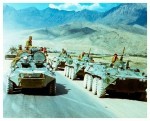
In private, US strategists were delighted with the events in Afghanistan. Not only did the Soviet intervention provide propaganda opportunities, the Soviets were confronted with what one American politician called “their own Vietnam”. Washington worked to make the Soviet task more difficult by destabilising the communist regime and arming and training its enemies. Working chiefly through Pakistan, US operatives began providing military equipment and funds to local Muslim fundamentalists, collectively known as the mujahideen (‘freedom fighters’). CIA agents worked underground in Afghanistan, training the mujahideen and recruiting new members; as much as $US20 billion was smuggled into the country for this purpose. Many who benefited from this American assistance later joined the Taliban, an Islamic group that seized control of Afghanistan in 1996. Another beneficiary of American aid during the Soviet occupation was a young Saudi-born volunteer named Osama bin Laden. American assistance increased under the presidency of Ronald Reagan; the US government set aside more than $US600 million a year to arm, train and support the Afghan resistance.
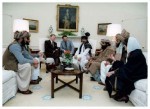
The Soviet Red Army found the occupation and stabilisation of Afghanistan a difficult task. By early 1980 Soviet forces controlled many of Afghanistan’s cities, main roads and infrastructure locations – but more than four-fifths of the country remained under the control of local tribes and Islamic groups. The Soviets launched a series of offensives to capture Afghan-controlled provinces but were frustrated by local resistance. The mujahideen employed sabotage, terrorism and guerrilla tactics against both Soviet soldiers and forces loyal to the civilian government. Electricity in the cities was regularly knocked out by attacks on power stations; government buildings were routinely bombed; politicians and public servants were assassinated. Mujahideen attacks on the powerful Soviet military were much less frequent, although small patrols and individual soldiers were often ambushed and murdered.
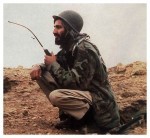
The Soviet-Afghan war continued until the mid-1980s, when Moscow decided to gradually withdraw its forces from Afghanistan. Local forces were built up and the Soviet presence was phased out. There was little fighting and only a couple of offensive campaigns after 1987. Almost 15,000 Soviet soldiers and personnel died during the USSR’s eight-year occupation of Afghanistan. In contrast, more than a half-million mujahideen and one million Afghani civilians were killed. There was enormous damage to the nation’s cities, infrastructure, farmland and livestock in what had been one of the world’s poorest countries, even before 1979.
“Soviet involvement in Afghanistan, particularly since World War II, had been clearly designed to bring Afghanistan under Soviet hegemony. The USSR had used several methods interactively. Prior to World War II the focus was on purely diplomatic initiatives and economic aid, but after the war the Soviets expanded their approach to include military assistance and political manipulation. By 1978 these methods had succeeded: the USSR was Afghanistan’s biggest trade partner and source of economic aid, it had modernised Afghanistan’s armed forces, and with its support, Afghanistan’s nascent communist party was running the country. But one of the bloodiest and most destructive wars in Afghanistan’s history was yet to come.”
Larry P. Goodson, historian
The Soviet withdrawal represented a Cold War victory for Washington but there would be long-term ramifications for the US. Without the backing of Soviet troops, the Afghanistan government collapsed, and the nation disintegrated into years of civil war. In 1996 a group of fundamentalist Sunni Muslims called the Taliban (“students”) gained control of the capital city, Kabul. For the next five years, the Taliban ruled Afghanistan with religious zeal and remorseless oppression, banning television and radio, outlawing Western dress and imposing Sharia law and brutal punishments. Perhaps the worst victims of Taliban rule were Afghan women, who were banned from employment, education or even leaving their homes without a male chaperone. The Taliban also gave safe harbour to a small group of Islamic terrorists calling themselves al-Qaeda (“the base”). It was in their Afghanistan training camps that Osama bin Laden and members of al-Qaeda plotted the September 11th 2001 terrorist attacks that murdered more than 3,000 people in the US.

1. Afghanistan is a landlocked Asian that shared borders with Iran, Pakistan and several Soviet republics. Until 1973 it was a relatively democratic and progressive state.
2. Two coups in the 1970s, instigated by the Communist People’s Democratic Party (PDPA) and backed by Moscow, led to a communist government taking power in Afghanistan.
3. This led to the growth of an anti-communist insurgency in many parts of Afghanistan. In late 1979 Soviet troops invaded the nation, purportedly at the request of the PDPA.
4. These anti-Soviet insurgents, called mujahideen, were local tribesmen backed and supplied by the US, through the CIA. One of them was future Islamic terrorist Osama bin Laden.
5. The Soviet occupation of Afghanistan lasted almost a decade and proved very costly, with almost 15,000 Russians dying there. The Soviet withdrawal of the late 1980s led to the rise of the Taliban, a fundamentalist Islamic group.
Content on this page is © Alpha History 2018. This content may not be republished or distributed without permission. For more information please refer to our Terms of Use.
This page was written by Jennifer Llewellyn, Jim Southey and Steve Thompson. To reference this page, use the following citation:
J. Llewellyn et al, “Soviets in Afghanistan”, Alpha History, accessed [today’s date], https://alphahistory.com/coldwar/soviets-in-afghanistan/.
